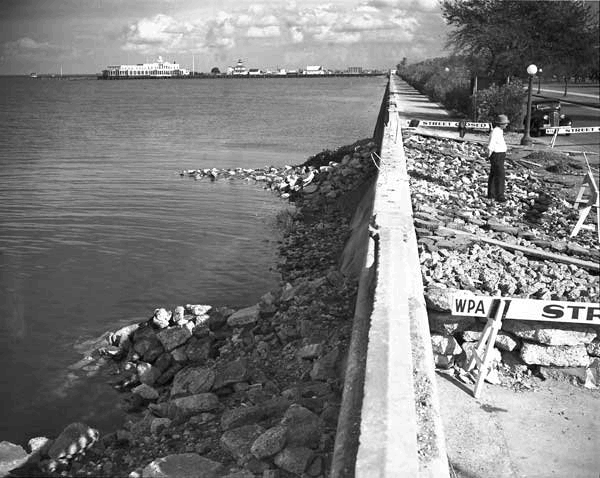|
Today in New Orleans History |
|
|
January 11


 Work at West End The 1920’s and 1930’s brought tremendous change to the shores of Lake Pontchartrain, much
of it still visible today. Massive land reclamation from West End to just east of the Industrial Canal left the Spanish
Fort and Milneburg attractions a half mile or so offshore. Milneburg camps were demolished. Some were moved by their owners
to N.O. East along Hayne Boulevard and to Little Woods. Reclaimed land fronting Milneburg became Pontchartrain Beach and
the Lake Terrace and Lake Oaks subdivisions. Pictured here is work in
progress to backfill near West End in preparation of building the municipal yacht harbor which would be "...second to
none in the South" according to the photo's caption written by the Works Progess Administration (WPA).
The new harbor was built by the WPA and the city of New Orleans. The Spanish
Fort amusement area (with the exception of the orginal Pontchartrain Beach) closed in 1926. The Southern Regional Research
Laboratory now abuts what was the old Spanish Fort resort property. Before the reclamation, the lakeshore reached approximately
to what is now Robert E. Lee Boulevard, which was then named Adams Avenue. In 1926, the New Orleans
Levee Board began driving pilings which would support sheet metal to be filled to reclaim land along the lakeshore at Milneburg.
Within a few years the Milneburg Light would be on dry land surrounded by the Pontchartrain Beach amusement park. The land
reclamation resulted in the end of Milneburg as a treasured lakeside summer spot. It was deactivated in 1929. Built on
piers in the lake with an adjacent keeper’s house it would later be surrounded by concrete in Kiddieland at the Pontchartrain
Beach Amusement Park. Having withstood the ravages of Hurricane Katrina this century and a half old structure can now be
found in the University of New Orleans Technology Center. By 1937 the New Orleans Lakeshore Drive
had been coined the "Great White Way". It was said to have one of the finest lighting systems in the South.
While the massive reclamation project was taking place on the New Orleans shore, across the lake in Mandeville the WPA had
plans to “beautify” the northern shore as well. A seawall was completed there in 1938. By the 1940’s
the New Orleans seawall stretched from West End to the Lakefront Airport. Established in 1838
and first lit in 1901, the New Canal Light (pictured in the center of the photo) sat at West End and what was the entrance
to the New Basin Canal. Francis D. Gott was awarded the contract to build this light as well as the Port Pontchartrain
and Pass Manchac lighthouses. In 1855 a new lighthouse replaced the original. The current West End/New Basin
Light was built in 1890 and moved to its current location in 1910. It was one of the few structures to survive the 1903
Cheniere Caminada storm when its female keeper Caroline Riddle housed survivors there. It was damaged during hurricanes
in 1926 and 1927, after which it was raised on raised on concrete piers. In 1936 the breakwater around the station was
filled in, placing the light on dry land. During Hurricanes Katrina and Rita, in 2005, the lighthouse was badly damaged
and lack of care resulted in it collapsing months after the storms. The Lake Pontchartrain Basin Foundation lovingly restored
it via public and private funding. The lighthouse now welcomes visitors inside to view historic and contemporary displays
Photo from the New Orleans Public Library. Text from Lake
Pontchartrain (LA) (Images of America)
 

To receive an update for each day in New Orleans history,
join our facebook page - Today in New
Orleans History
Born in New Orleans on November 19, 1848, Warren Easton was Louisiana's first superintendent of education from 1884 to 1888. On October 11, 1888 he was elected the first superintendent of New Orleans Public Schools which, at that time had 414 teachers and 24,800 students in 51 schools. In 1910, when he died in office, the teacher count had risen to 1,122 teachers of 38,098 students in day classes at 87 schools and 105 teachers of 4,035 students at nine night schools. During his twenty-two-year tenure in New Orleans, Easton opened classes in calisthenics, drawing, short-hand, typing, and music. He submitted the first typewritten superintendent's report on January 11, 1889. He died in New Orleans on October 17, 1910 and is buried in Greenwood Cemetery. Warren Easton High School, opened in 1913, was named for him. Source: http://lahistory.org/site.php?pageID=2
James Waller Breedlove, soldier, politician, businessman. Born, Albermarle County, Va., ca.
1790. Served in War of 1812. Later removed to Tennessee where he formed a lifelong friendship with Andrew Jackson.
Married (1) Maria Eliza Winchester (1793-1848), daughter of Gen. James Winchester. Seven children, four of whom grew
to maturity. Married (2) Elizabeth Gill, in Newport, R. I., July 26, 1850 (she died shortly thereafter). Removed
to New Orleans, ca. 1818; invested in several small merchant vessels. Befriended Stephen F. Austin (q.v.); served
as Mexican vice-consul in New Orleans, 1829-1831. Served as collector, Port of New Orleans, 1830s; president of Atchafalaya
Bank. Prominent leader of the Democratic party, 1840s. Backed American filibusterers in Cuba, 1850. Unsuccessful
candidate for mayor of New Orleans, 1854, on the Independent Reform Ticket. Supported the Confederacy but did not
serve in army. Died, New Orleans, January 11, 1867; interred Girod Street Cemetery. R.S.J.
Sources: John S. Kendall, "Andrew Jackson's Correspondence with James W. Breedlove," Louisiana Historical
Quarterly, VI (1923); Chester Stanley Urban, "New Orleans and the Cuban Question during the Lopez Expeditions of 1848-1851,"
Louisiana Historical Quarterly, XXIII (1939); Eugene C. Barker, ed., The Austin Papers, II; Ship Registers and Enrollments
of New Orleans, Vols. I-III; New Orleans Daily Picayune, August 7, 1850. From http://lahistory.org/site19.php
|
|
|

To receive an update for each day in New Orleans history,
join our facebook page - Today in New
Orleans History.
Analytics |


